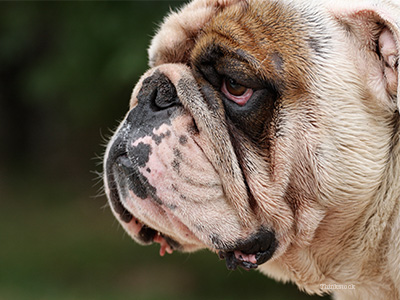Keratoconjunctivitis is an awfully long word that basically means any inflammation (“itis”) of both the cornea (“kerato”) or the transparent part of your eye that you see through and the “conjunctiva” -- the pink mucous membrane that covers the insides of your eyelids and attaches to the opaque, white part or sclera of the eye. You may know from your own experience that your eyes are vulnerable to trauma and irritation from things like wind, dryness, infections and foreign bodies. It’s not surprising, then, that your dog’s eyes are also sensitive to developing keratoconjunctivitis.
 What are the symptoms of keratoconjunctivitis?
What are the symptoms of keratoconjunctivitis?
Again, you can probably guess this based on your own experience. The inflammation causes:
- Redness
- Swelling of the eyelids and conjunctiva
- Itchiness (your dog may rub his face and eyes)
- Pain
- Squinting (either from pain or from sensitivity to light)
- Discharge from eyes (clear, excessive tearing to thicker, mucous) that might even ‘glue’ eyelids closed especially after sleeping
- Cloudy appearance of the corneal surface
- Decreased visual acuity
Not all symptoms will occur in all cases and the condition may only exist in one eye or both eyes depending on the cause.
What causes keratoconjunctivitis in dogs?
Remember, since this is an “itis,” it can be caused by anything that causes irritation or inflammation to the eye. Some causes include:
- Environmental irritants (dryness, dust, smoke, etc.)
- Allergies
- Infections like distemper
- Immune-mediated disorders
- Keratoconjunctivitis sicca or dry eye
The last one, Keratoconjunctivitis sicca (known as KCS) or ‘dry eye’ is a very common disorder in dogs. Just as keratoconjunctivitis in general can have many causes, so can the more specific KCS. KCS can also be due to a hereditary predisposition (like in Cocker Spaniels, Boston Terriers and other breeds) and often times due to an immune mediated disorder where your dogs own immune system is the culprit1.
As the name, dry eye, implies, the issue in KCS is a lack of adequate moisture/tears in the eye. Normal tears in normal amounts are essential for healthy eyes. Imagine if you had blood vessels running across the surface of your eye. It would be difficult to see properly. That’s why they aren’t there. But nutrients and antibodies and everything else that blood would deliver to your eyes has to get there somehow. That’s what tears do. Without them bad things happen -- more inflammation or infection occurs, the cornea dries out, it becomes cloudy, opaque, ulcerated and or pigmented and vision is impaired. If left untreated these changes are at the very least extremely painful, and in the worst cases they can be irreversible so that your dog may even lose his sight.
How is keratoconjunctivitis diagnosed and treated?
Your veterinarian will, of course, need to do a thorough examination of your dog’s eyes (checking for any abnormalities, ulcers, tear production and vision deficits). In addition, a complete physical examination and other tests may be needed to rule out any suspected underlying problems that might be contributing to the inflammation in your dog’s eye(s) so those can be addressed while specific treatment for the ocular symptoms are instituted.
In general, you can expect that the application of some form of eye drops or ointments will be required to bring your dog relief. The type of product may vary depending on the presence or absence of infection, ulcers, cloudiness, etc. In cases of KCS, replacement artificial tears need to be instilled in the eye multiple times a day -- at least temporarily and in many cases forever going forward. In other cases, a topical preparation including immunosuppressant drugs like Cyclosporine or Tacrolimus applied twice daily can be very effective in stimulating natural tear production again (though even that will need to be continued for the life of your dog)1.
Your ultimate goal is not only to keep your dog comfortable in the short term but also to preserve vision for the long haul. Keratoconjunctivitis and KCS should be treatable, controllable problems even if they aren’t entirely curable, but it is very important that you follow your veterinarian’s recommendations and instructions in order to obtain the very best outcome possible.
If you have any questions or concerns, you should always visit or call your veterinarian -- they are your best resource to ensure the health and well-being of your pets.
1. "Keratoconjunctivitis Sicca." NC State University - College of Veterinary Medicine. Web.
